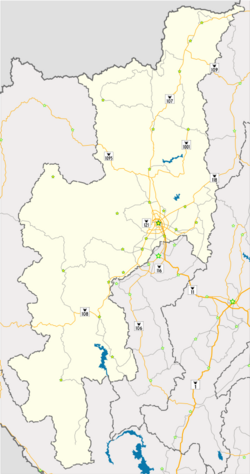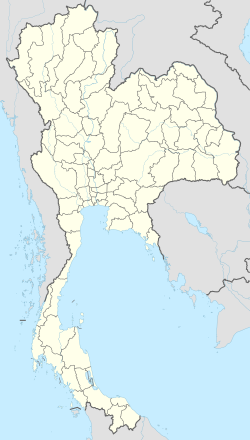| Wat Ku Tao | |
|---|---|
| วัดกู่เต้า | |
 | |
| Religion | |
| Affiliation | Buddhism |
| Sect | Theravada Buddhism |
| District | Mueang Chiang Mai District |
| Province | Chiang Mai Province |
| Location | |
| Municipality | Chiang Mai |
| Country | Thailand |
  | |
| Geographic coordinates | 18°48′09″N 98°59′19″E / 18.802366°N 98.988744°E / 18.802366; 98.988744 |
Wat Ku Tao (Thai: วัดกู่เต้า; "Temple of the Gourd Pagoda") is a Buddhist temple in Chiang Mai, Thailand. The temple was built in 1613 to enshrine the remains of Nawrahta Minsaw, the first Burmese ruler of Lan Na. The temple is known for its distinctive chedi, which was built in the Yunnanese style, arranged in a series of five diminishing spheres that represent the five historical and future Buddhas. The temple presently caters to Chiang Mai's Shan community.
Formerly known as Wat Veru Vanaram, the temple features a striking pagoda resembling a stack of five watermelons, earning it the local moniker "Chedi Ku Tao" (meaning "watermelon pagoda" in Lanna dialect). Both its architecture, interior decor, and enshrined Buddha images showcase a strong influence of Burmese artistic traditions. History points to the importance of the temple as the home to the ashes of Nawrahta Minsaw, the first Burmese overlord of Chiang Mai.
Poy Sang Long Ceremony
In the present day, one of the two prominent Tai Yai (Shan) temples in Chiang Mai is the venue for the annual Poy Sang Long ceremony. The other temple, Wat Pa Pao, is located north of the moat. This traditional ceremony typically occurs towards the end of March or the beginning of April.
The essence of the festival is deeply rooted in Shan or Tai Yai culture, signifying the act of "ordaining the beloved sons." Boys aged 7 to 14 participate by going to the temple to be ordained as novices. During this process, they acquire knowledge of Buddhist teachings and the self-discipline expected of a monk. Following their ordination, the newly ordained novices reside in the monastery for a variable duration, ranging from a week to several months or more. It is common for a sizable group of boys to undergo ordination simultaneously.
The temple also hosts the annual Shan New Year festival, marking the conclusion of the Shan calendar year. This festive celebration is a significant event that draws participants and spectators to partake in cultural festivities and traditional ceremonies at the temple.
References
- ^ Freeman, Michael (2001). Lanna: Thailand's Northern Kingdom. Thames & Hudson. ISBN 9780500976029.
- Eberhardt, Nancy (2009-05-01). "Rite of Passage or Ethnic Festival? Shan Buddhist novice ordinations in northern Thailand". Contemporary Buddhism. 10 (1): 51–63. doi:10.1080/14639940902968913. ISSN 1463-9947.
- ""วัดกู่เต้า" / ล้านนาคำเมือง". Matichon Weekly.
- "พระเจดีย์ 'กู่เต้า' บรรจุอัฐิเจ้าฟ้าสาวัตถี โอรสของพระเจ้าบุเรงนองจริงหรือไม่? | มติชนสุดสัปดาห์". LINE TODAY (in Thai).